It occurred to me that despite having been back in North America for sixth months, I haven’t really posted anything on my trip. This summer I spent a month in Turkey, primarily visiting late Roman and Byzantine sites, and a vast number of them. I was continually impressed by the quality and size of the Roman ruins in Turkey. They certainly dwarf anything that I’ve seen in Italy, and there are numerous Pompeii-sized cities just about everywhere in the western half of the country. The first week was spent in Istanbul. Then we flew down to Antalya (ancient Attaleia) on the south coast, rented a car, and headed east, before returning to the western half of the country and thoroughly exploring the southwest coast and parts of the central Aegean coast.
Istanbul was an incredible experience, although it was also sad to see the state of preservation of many of the Byzantine monuments. For the sake of this post, I am going to concentrate on the Byzantine buildings. This is not to suggest that there are not other things worth seeing in Istanbul. The major Ottoman mosques are quite impressive on the outside, even if on the inside they are almost entirely identical to each other and it is hard to get a good view of the elaborately painted ceilings on account of the vast number of cables coming down that hold up the lights. The St. Stephan of the Bulgars church is also worth stopping in, purely to see a hideous pre-fabricated metal Austrian church in all of its rusting glory.
The first church up is no longer a church. The Church of the Theotokos Pammakaristos actually has a bit of important history behind it, as it served for about 130 years as the Greek patriarchate in Constantinople after Mehmed II decided to bulldoze Justinian’s Church of the Holy Apostles. (While that act certainly caused a serious loss to posterity, the church seems to have been utterly decrepit when the Ottomans took the city in 1453.) Pammakaristos may have been a Komnenian foundation, and there is some slight evidence that Alexios I Komnenos, the emperor who called the First Crusade, was buried there. The church is still a mosque today, but the parekklesion (side church) has been restored and is now a museum. Although its interior is quite small, it is an absolutely brilliant building and it is covered in gold mosaic. The decorations inside date from the early 14th century.
Central dome and apse. Old Testament prophets flank the dome, and a large Christ dominates the apse.
Sure, the curve seems a little odd, but it never alters the perspective of the figure.
Look carefully, and you can see some fresco hidden behind a crack in the brick, just there to make us wonder what sort of beautiful art remains covered in the mosque itself. You’ll probably have to look at the full size image to see the fresco.
The Christ Pantokrator from the dome. Since there was no one else there, I managed to get such a good picture by laying on my back beneath the dome and resting my arms on the floor to create a sort of tripod for my camera. It got a good picture, but the experience of laying the cool stone floor with golden Byzantine mosaics all around me was fantastic. This exact image now adorns my wall in gorgeous 8″x10″.
South wall of the church. Much of the decoration is gone, but most of the lower mosaics are intact, and the marble still looks good seven hundred years later.
The Küçuk Ayasofya is another mosque that was once a Byzantine church. It was a particularly famous Byzantine church, for this was Justinian’s church of Sts. Sergios and Bakchos. Most of its Byzantine decorations are gone, but even as a mosque today it remains an important part of the Byzantine heritage in Istanbul. The marble floor is now carpeted, something that you can hardly fault the Muslims for because it just feels so nice to take off your shoes and wander around mosques in your socks after long walks from site to site. The plan of the building is still very evident, and you can see why the Turks call it Küçuk Ayasofya, “Little Hagia Sophia.” It is a miniature version of that monumental structure, albeit with less of a nave and more of a centralized plan. In the Hagia Sophia you can at least see the basilical base to the church, but Sts. Sergios and Bakchos is much more rounded. How much of the original decoration lies under the Turkish plaster is anyone’s guess, and as far as I know no art or architectural historians have yet had the opportunity make some experimental cuts in the walls to see what might be underneath.
Part of the fun of exploring this building was hunting down its Byzantine heritage. The column capitals, at one point as elaborate as those supporting the Hagia Sophia, have suffered whitewashing, but their original intricacy is still visible underneath.
The carvings that wrap around the interior are also original, but are particularly notable for two things. The first is that their Greek inscriptions remain. The second is that the despite the church being dedicated to two saints, St. Bakchos seems to have got the shaft when it came to getting his name carved in. Only St. Sergios is mentioned.
Another great part about this mosque is the gallery. Unlike some troublesome churches in Europe, they let you go up into the gallery in this mosque for a different view.
 Not much remains of the grand hippodrome of Constantinople other than its shape and some of the decorations on the spina. Still, we should consider ourselves fortunate, because there is more of it left than the Circus Maximus in Rome, which is nothing more than an earthen depression. Because of the hilly nature of Constantinople, the hippodrome had to be built up quite a ways on the sphendone end to accommodate the massive size of the track. Modern construction has been built over one end of the hippodrome so even though you can wander into it and appreciate how big it is, you aren’t really getting the full size unless you go to the far end to see the exposed substructure of the sphendone. This isn’t even my picture of it. 6000 Turkey pictures, and I don’t have a decent one looking down to the hippodrome, probably because it was getting paved while I was there and thus filled with bright orange fencing, piles of bricks, and construction workers. I was forced to steal this picture from Wikipedia. The green spaces around the obelisks no longer exist. The entire area in front of the Blue Mosque is covered with large bricks. The Blue Mosque is the building to the right, and the Hagia Sophia is the more distant red building. The nearer column was erected by Constantine VII in the tenth century. The further one was brought from Egypt by Theodosius I in 390, and contains some carvings of his court.
Not much remains of the grand hippodrome of Constantinople other than its shape and some of the decorations on the spina. Still, we should consider ourselves fortunate, because there is more of it left than the Circus Maximus in Rome, which is nothing more than an earthen depression. Because of the hilly nature of Constantinople, the hippodrome had to be built up quite a ways on the sphendone end to accommodate the massive size of the track. Modern construction has been built over one end of the hippodrome so even though you can wander into it and appreciate how big it is, you aren’t really getting the full size unless you go to the far end to see the exposed substructure of the sphendone. This isn’t even my picture of it. 6000 Turkey pictures, and I don’t have a decent one looking down to the hippodrome, probably because it was getting paved while I was there and thus filled with bright orange fencing, piles of bricks, and construction workers. I was forced to steal this picture from Wikipedia. The green spaces around the obelisks no longer exist. The entire area in front of the Blue Mosque is covered with large bricks. The Blue Mosque is the building to the right, and the Hagia Sophia is the more distant red building. The nearer column was erected by Constantine VII in the tenth century. The further one was brought from Egypt by Theodosius I in 390, and contains some carvings of his court.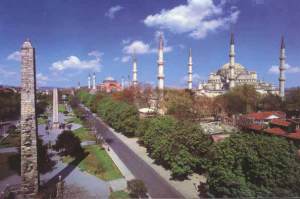 This is the famous bronze serpent column from Delphi, originally cast after the Battle of Plataea in the 5th c. B.C. It was brought to Constantinople by Constantine I. One of the heads is in the Istanbul Museum. Amazingly enough, they lasted into the seventeenth century, only to be allegedly damaged by a drunken Polish nobleman. We have a sixteenth century Ottoman miniature that depicts the heads still on the column.
This is the famous bronze serpent column from Delphi, originally cast after the Battle of Plataea in the 5th c. B.C. It was brought to Constantinople by Constantine I. One of the heads is in the Istanbul Museum. Amazingly enough, they lasted into the seventeenth century, only to be allegedly damaged by a drunken Polish nobleman. We have a sixteenth century Ottoman miniature that depicts the heads still on the column.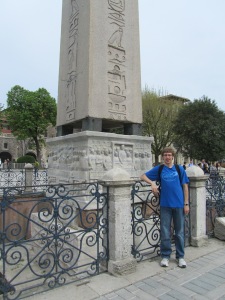
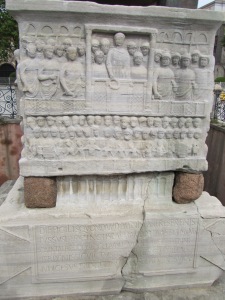 Unfortunately, the obelisk of Constantine VII was undergoing repairs and covered in scaffolding, so I don’t have a good picture of it. So here’s some pictures of the substructure of the sphendone. This is construction allowed the hippodrome to be much bigger than topography would allow, and was constructed in the typical Roman style of using massive vaults to shape the land however they wanted it. Today some sort of school sits on the end of the hippodrome where seating and the hairpin turn that the chariot racers had to be make would have been.
Unfortunately, the obelisk of Constantine VII was undergoing repairs and covered in scaffolding, so I don’t have a good picture of it. So here’s some pictures of the substructure of the sphendone. This is construction allowed the hippodrome to be much bigger than topography would allow, and was constructed in the typical Roman style of using massive vaults to shape the land however they wanted it. Today some sort of school sits on the end of the hippodrome where seating and the hairpin turn that the chariot racers had to be make would have been.
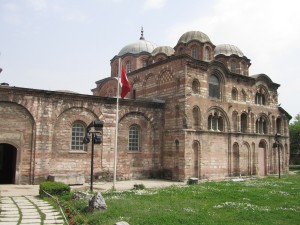
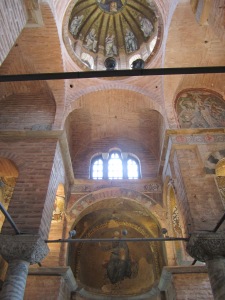
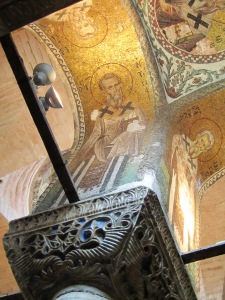
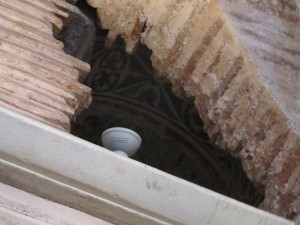
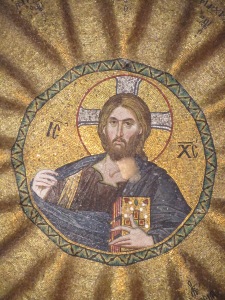
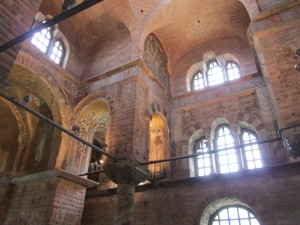
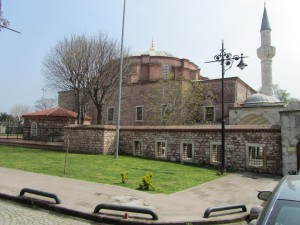
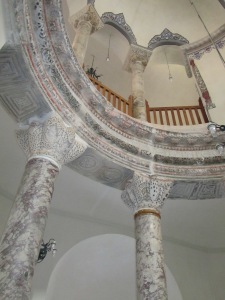
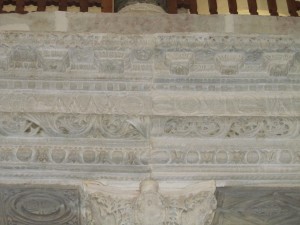
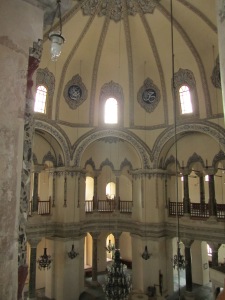
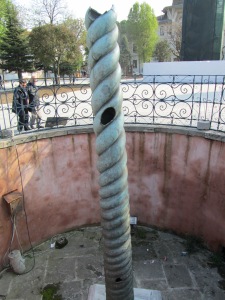
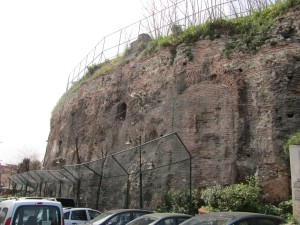
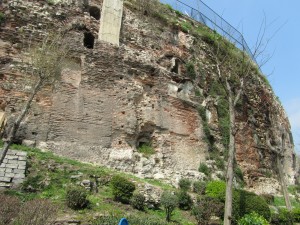
Δεν υπάρχουν σχόλια:
Δημοσίευση σχολίου